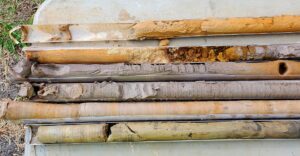“Silly Putty” Clays

“Silly Putty” Clays
bad for foundations, good for containment of environmental contaminants
Environmental scientist Carol Phillips couldn’t believe her eyes retrieving soil samples from a subsurface exploration she was performing to check for metal, volatile organic compounds and other potential environmental contaminants. Pulling the sleeves from the borings, she discovered thick, high plasticity clays of a beautiful array of colors. From a very light lavender color to an almost turquoise color and bright orange sand layer, this was one of the most exciting soil samples she has ever seen.
“Phoning a friend,” Carol reached out to Rhea Sublett, staff geologist who offered some background information on the lacustrine deposits from the glacial Lake Monongahela, the region of her subsurface exploration. Lake Monongahela was formed a few hundred thousand years ago during an ice age where the glaciers dammed river flow to create a lake extending from approximately Pittsburgh, PA south to Clarksburg, WV. Lake Monongahela no longer exists, but after the glacier receded, its waters created what is now the Ohio River.
The unique history of Lake Monongahela has created fascinating and challenging geologic patterns and conditions in and around Morgantown. The fine-grained lacustrine deposits are the consistency of Silly Putty and often extend up to 80 feet below existing grades. The shrinking and swelling clay materials are problematic for building foundations and construction. However, the thick make-up of the clay materials may help slow or prevent the spread of potential environmental contaminants on the property being evaluated in Carol’s study.
Offering geotechnical engineering, environmental consulting and our many other services in house creates amazing opportunities for collaboration and learning. At Triad, we’re grateful for our diverse, complementary service offerings and our talented staff.


